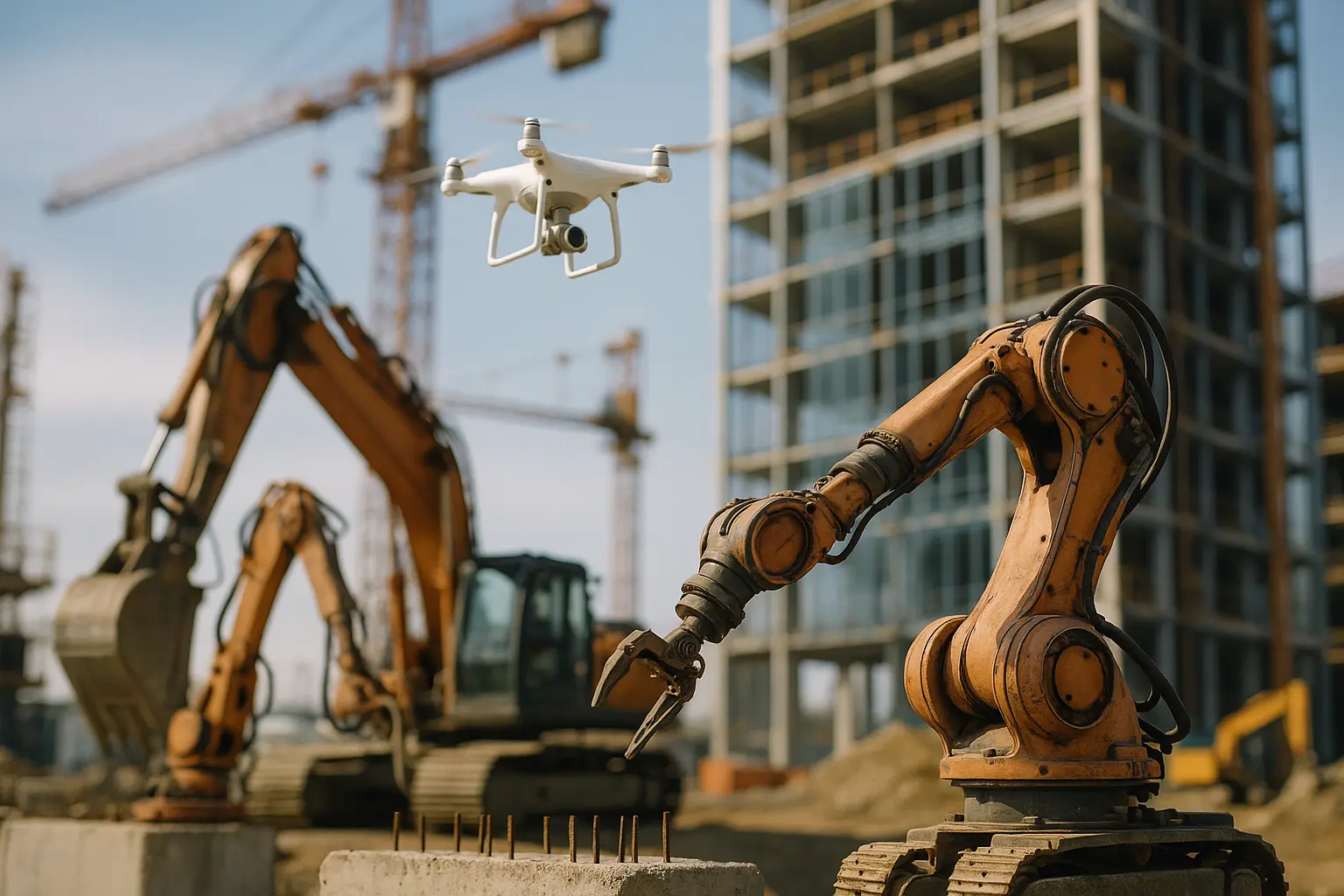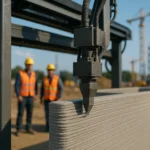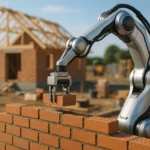In the fast-evolving realm of construction, automation is an undeniable catalyst, transforming traditional approaches and propelling us toward a future defined by efficiency, safety, and innovation. Our industry, once reliant on manual tasks and labor-intensive processes, is now at the cusp of a technological revolution. The advent of automated technologies is not only speeding up building projects, but it’s also reshaping the entire landscape of project management.
With the integration of cutting-edge software, drones, and other tools, we’ve witnessed a marked enhancement in time management and overall project throughput. Gone are the days when construction sites were synonymous with delays and budget overruns. Automation is bridging the gap between architectural dreams and reality, one project at a time. Let’s delve into this transformative journey and explore how automation is revolutionizing our industry.
Enhancing Efficiency with Automated Tools
The construction industry has long been plagued by inefficiencies and persistent challenges that delay project completion. However, the introduction of automated tools is gradually shifting this narrative.
Imagine a construction site where drones survey the landscape, capturing detailed data and providing real-time insights to project managers. These drones are capable of monitoring progress, identifying potential risks, and ensuring that all processes are smoothly aligned with the initial architectural blueprints. By leveraging these automated tools, we can significantly enhance the efficiency of our operations.
Automated machinery plays a crucial role in streamlining tasks that once consumed a substantial amount of time and labor. Innovations such as robotic bricklayers, automated bulldozers, and self-operating cranes are becoming increasingly common. These technologies not only reduce the time spent on manual labor but also minimize human error, leading to more precise and reliable outcomes.
Moreover, advanced software solutions enable us to manage projects with unprecedented accuracy. By centralizing data, these systems allow for seamless coordination between various stakeholders, ensuring that everyone is on the same page. Project timelines can be monitored and adjusted as needed, thanks to predictive analytics and data-driven insights, which further boost efficiency.
The shift toward automation doesn’t only benefit construction companies. It also results in faster project deliveries, reduced costs, and ultimately, increased customer satisfaction. In an industry where time equates to money, embracing automated technologies is no longer optional but essential.
Safety First: Automation and Risk Management
Safety remains a paramount concern in the construction industry, with workers constantly exposed to potential hazards. However, automation is paving the way for a safer workplace by mitigating risks and enhancing safety protocols.
By adopting automated systems, we can significantly reduce the need for human intervention in dangerous environments. Robotics and AI-driven tools perform high-risk tasks with remarkable precision, minimizing the likelihood of accidents. For instance, drones equipped with advanced imaging technologies can inspect hard-to-reach areas, identifying structural weaknesses or other issues without putting workers in harm’s way.
In addition to physical safety, automation also improves health conditions on construction sites. Automated machinery reduces the need for strenuous manual labor, lessening the risk of musculoskeletal injuries. This allows workers to focus on tasks requiring human judgment and creativity.
Moreover, automated systems enhance site monitoring and compliance with safety regulations. Real-time data collection and analysis help identify potential risks before they escalate, allowing for proactive measures to be taken. Safety managers receive alerts when parameters deviate from the norm, ensuring that potential dangers are swiftly addressed.
Incorporating automation into construction projects fosters a culture of safety, empowering workers to perform their duties confidently and efficiently. By prioritizing safety, we not only protect our workforce but also build trust with clients and stakeholders, reinforcing the reputation of construction as a forward-thinking and responsible industry.
The Power of Data-Driven Decisions
In the digital age, data is the lifeblood of innovation, and the construction industry is no exception. Automation has transformed how we collect, analyze, and apply data to make informed project decisions.
With advanced software and automated monitoring systems, we can gather data from every corner of a construction site, from material usage to workforce performance. This influx of information empowers project managers to make precise, data-driven decisions that optimize time, resources, and overall efficiency.
Real-time data analytics offer insights that enable us to spot trends and patterns, adjust project timelines, and preemptively address potential bottlenecks. This level of foresight was unimaginable a few decades ago, but today, it is essential for successful project execution.
Automation also facilitates effective communication among project stakeholders. By translating complex data into user-friendly dashboards and reports, team members can easily access the information they need, fostering collaboration and aligning efforts toward a common goal.
Furthermore, data transparency promotes accountability and trust within the construction process. Clients and investors can monitor progress, budgets, and quality standards in real-time, ensuring that projects stay on track and meet expectations.
Harnessing the power of data through automation allows us to adapt to changing demands, enhance project outcomes, and remain competitive in an ever-evolving industry landscape. As we continue to embrace automated technologies, we unlock new possibilities for construction, turning challenges into opportunities for growth and innovation.
The Future of Automated Construction
As we stand on the brink of a new era in construction, the promise of automation is more apparent than ever. The future of our industry will be characterized by the seamless integration of automated technologies, reshaping how we approach building projects.
Drones will soon become a staple on construction sites, not just for surveying but for delivering materials and even performing intricate assembly tasks. Robotic systems, powered by AI, will tackle complex tasks with unprecedented precision, reducing the dependency on human labor in dangerous or repetitive roles.
The rise of automation will also introduce new technologies that we have yet to fully imagine. From smart materials that self-repair to AI-driven project management solutions that predict outcomes with uncanny accuracy, the possibilities are endless.
However, the road to full automation will require a concerted effort from all stakeholders. Investing in employee training, fostering innovation, and addressing ethical considerations will be critical to ensuring that the benefits of automation are realized without compromising job security and industry standards.
In this automated future, we will witness a construction industry that is not only more efficient and safe, but also more sustainable and adaptable. With automation at the helm, we can look forward to an era where construction defies limitations, delivering projects that not only meet but exceed expectations.
As we embrace this technological transformation, let us remain committed to the core values that define our industry—innovation, integrity, and excellence. Together, we will build the future, one automated step at a time.
In our journey through the transformative power of automation in building projects, we’ve explored how automated technologies are redefining construction by enhancing efficiency, bolstering safety, and empowering data-driven decisions.
As we stand at the intersection of traditional practices and technological innovation, it’s clear that automation is not merely an add-on—it’s a vital component of our industry’s future success. By embracing these advancements, we’ve not only accelerated project timelines but also forged a path toward a safer, more productive, and more sustainable future.
The future is bright for construction, where automation leads the way in unlocking boundless possibilities. Let’s seize this opportunity to build a world where projects are completed with precision, safety, and foresight. Together, we will continue to push the boundaries, defining a new era of construction that thrives on innovation and progress.
FAQ
What role does automation play in expediting construction projects?
Automation streamlines various processes in construction, reducing the time spent on tasks and minimizing human error. This efficiency allows for faster project completion while maintaining quality.
How does automation improve the accuracy of construction tasks?
Automated tools and machinery carry out tasks with high precision and consistency, minimizing the risk of mistakes that could lead to delays or additional costs due to rework.
Can automation reduce labor costs in construction projects?
Yes, automation can lead to significant savings in labor costs by reducing the need for manual intervention and allowing fewer workers to achieve more in less time.
What types of automated technologies are commonly used in construction?
Common automated technologies include 3D printing of building components, drones for site surveys, robotic bricklayers, and automated machinery for tasks such as excavation and assembly.
Are there any challenges associated with implementing automation in construction?
While automation offers numerous benefits, challenges include the initial investment cost, the need for specialized training, and the integration of new technologies into existing workflows.



